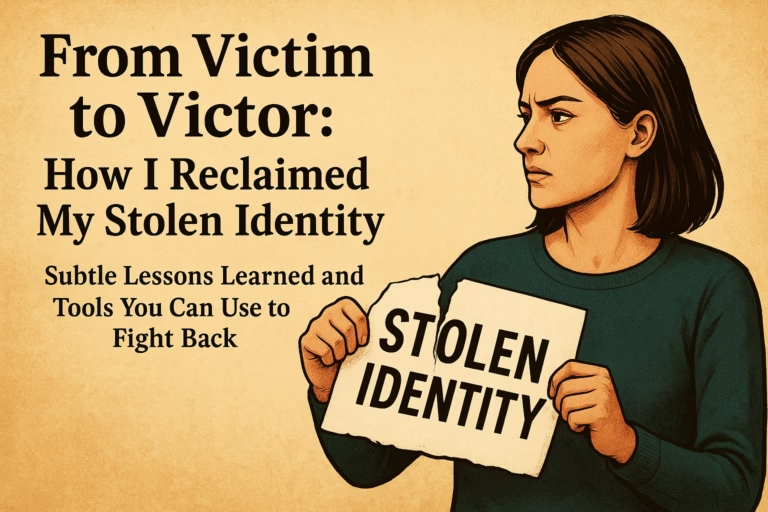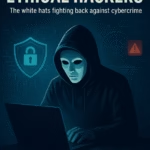Lessons learned and tools you can use to fight back
The Day My Life Changed
It started with a phone call I’ll never forget. A collections agency was demanding payment for a credit card I’d never opened. Within 48 hours, I discovered someone had stolen my identity, opened multiple accounts in my name, and racked up over $30,000 in fraudulent charges. I felt violated, powerless, and overwhelmed.
But I refused to remain a victim. This is the story of how I fought back, reclaimed my identity, and what I learned along the way that can help you protect yourself—or recover if this nightmare happens to you.
Understanding the Scope of Identity Theft
Identity theft affects millions annually. According to recent data, approximately 1 in 4 Americans have experienced some form of identity theft. The emotional and financial toll is staggering, but recovery is possible with the right approach.
Common Types of Identity Theft:
- Financial Identity Theft: Unauthorized use of credit cards, bank accounts, or loans
- Medical Identity Theft: Using someone’s information to obtain medical services
- Criminal Identity Theft: Giving another person’s name during an arrest
- Synthetic Identity Theft: Combining real and fake information to create new identities
- Child Identity Theft: Stealing a minor’s Social Security number
My Recovery Journey: The Step-by-Step Process
Phase 1: Immediate Action (Days 1-3)
What I Did:
- Placed Fraud Alerts – I contacted one of the three major credit bureaus to place an initial fraud alert. This automatically notified the other two bureaus.
- Obtained Credit Reports – I reviewed all three reports from:
- Equifax (https://www.equifax.com)
- Experian (https://www.experian.com)
- TransUnion (https://www.transunion.com)
- Filed an FTC Report – I reported the identity theft at https://identitytheft.gov, which generated an official Identity Theft Report and recovery plan.
- Contacted Financial Institutions – I immediately called every bank, credit card company, and financial institution where fraud occurred.
Phase 2: Documentation & Disputes (Weeks 1-4)
This phase required meticulous organization. I created a comprehensive tracking system:
| Date | Institution | Action Taken | Reference Number | Follow-up Date | Status |
|---|---|---|---|---|---|
| Example: 03/15/24 | Bank of America | Filed dispute | #12345ABC | 04/15/24 | Resolved |
Key Documents I Gathered:
- Police report (filed at local precinct)
- Identity Theft Affidavit (FTC Form)
- Copies of fraudulent bills and statements
- Timeline of discovery
- All correspondence with creditors
Phase 3: Credit Freeze & Long-Term Protection (Ongoing)
I implemented a credit freeze with all three bureaus—different from a fraud alert, this completely locks your credit file:
- Equifax Freeze: https://www.equifax.com/personal/credit-report-services/credit-freeze/
- Experian Freeze: https://www.experian.com/freeze/center.html
- TransUnion Freeze: https://www.transunion.com/credit-freeze
Cost: Free by federal law
Effect: Prevents new accounts from being opened without your explicit permission
Essential Tools & Resources That Saved Me
Government Resources
| Resource | Website | Purpose |
|---|---|---|
| IdentityTheft.gov | https://identitytheft.gov | Official FTC recovery site with personalized plans |
| Consumer Financial Protection Bureau | https://www.consumerfinance.gov | File complaints, get guidance on rights |
| Social Security Administration | https://www.ssa.gov/number-card | Report SSN misuse |
| IRS Identity Protection | https://www.irs.gov/identity-theft-fraud-scams | Prevent tax fraud |
Credit Monitoring Services I Recommend
After comparing options, I chose multi-bureau monitoring:
- Credit Karma (https://www.creditkarma.com) – Free monitoring for TransUnion & Equifax
- Experian IdentityWorks – Comprehensive paid service with identity restoration specialists
- Privacy.com (https://privacy.com) – Virtual card numbers for online purchases
Password & Security Tools
- Password Manager: Switched to 1Password or Bitwarden to generate and store unique passwords
- Two-Factor Authentication: Enabled on every account possible using Authy or Google Authenticator
- Email Security: Created dedicated email addresses for financial accounts only
The Hidden Costs They Don’t Tell You About
Beyond the stolen money, identity theft cost me:
- 120+ hours of phone calls, paperwork, and follow-ups
- Lost work time and productivity
- Emotional stress requiring therapy support
- Upgraded security services (~$200/year)
But here’s what I gained:
- Complete financial awareness
- Ironclad security practices
- Advocacy skills to help others
- Peace of mind from knowing I’m protected
Warning Signs You Need to Watch For
Learn from my mistakes. I ignored these red flags:
⚠️ Small, unfamiliar charges on credit cards (thieves test cards with small amounts)
⚠️ Missing mail or bills that should arrive regularly
⚠️ Denied credit despite good financial standing
⚠️ Calls from debt collectors about unknown accounts
⚠️ Medical bills for services you didn’t receive
⚠️ IRS notice about unreported income
⚠️ Data breach notifications (don’t ignore these!)
My 10 Non-Negotiable Security Rules Now
- Credit freeze on all three bureaus – Lift only when applying for credit
- Unique passwords for every account (15+ characters)
- Two-factor authentication on everything
- Never click email links – Always navigate directly to websites
- Shred all documents containing personal information
- Monitor credit monthly – Set calendar reminders
- Use virtual card numbers for online shopping
- Freeze ChexSystems (https://www.chexsystems.com) – Prevents bank account fraud
- Opt out of prescreened credit offers at https://www.optoutprescreen.com
- Annual security audit – Review all accounts, subscriptions, and permissions
What to Do If This Happens to You
Your 24-Hour Action Plan:
Hour 1:
- Place fraud alert: Call Equifax (800-525-6285), Experian (888-397-3742), or TransUnion (800-680-7289)
- Change all online passwords immediately
Hours 2-4:
- File FTC report at https://identitytheft.gov
- Order credit reports from all three bureaus
- Document everything – screenshots, emails, calls
Hours 4-8:
- Contact all affected financial institutions
- File police report (required for many disputes)
- Notify your employer if work email compromised
Hours 8-24:
- Close or freeze compromised accounts
- Set up fraud alerts with utility companies
- Contact the Social Security Administration if SSN compromised
The Unexpected Silver Lining
Recovering from identity theft forced me to completely transform my relationship with personal security. I now:
- Understand my financial life intimately
- Have systems that protect my entire family
- Feel empowered rather than paranoid
- Help others navigate this nightmare
The statistics are sobering, but recovery is 100% achievable.
Additional Resources for Continued Protection
Legal Help:
- NCLC (National Consumer Law Center): https://www.nclc.org – Consumer rights advocacy
- NACBA (National Association of Consumer Bankruptcy Attorneys): For extreme case



